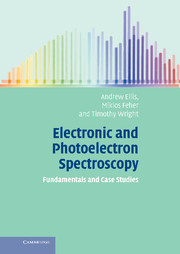Book contents
- Frontmatter
- Contents
- Preface
- List of journal abbreviations
- Part I Foundations of electronic and photoelectron spectroscopy
- Part II Experimental techniques
- Part III Case Studies
- 13 Ultraviolet photoelectron spectrum of CO
- 14 Photoelectron spectra of CO2, OCS, and CS2 in a molecular beam
- 15 Photoelectron spectrum of NO–2
- 16 Laser-induced fluorescence spectroscopy of C3: rotational structure in the 300 nm system
- 17 Photoionization spectrum of diphenylamine: an unusual illustration of the Franck–Condon principle
- 18 Vibrational structure in the electronic spectrum of 1,4-benzodioxan: assignment of low frequency modes
- 19 Vibrationally resolved ultraviolet spectroscopy of propynal
- 20 Rotationally resolved laser excitation spectrum of propynal
- 21 ZEKE spectroscopy of Al(H2O) and Al(D2O)
- 22 Rotationally resolved electronic spectroscopy of the NO free radical
- 23 Vibrationally resolved spectroscopy of Mg+–rare gas complexes
- 24 Rotationally resolved spectroscopy of Mg+–rare gas complexes
- 25 Vibronic coupling in benzene
- 26 REMPI spectroscopy of chlorobenzene
- 27 Spectroscopy of the chlorobenzene cation
- 28 Cavity ringdown spectroscopy of the a1Δ ← X3Σ–g transition in O2
- Appendix A Units in spectroscopy
- Appendix B Electronic structure calculations
- Appendix C Coupling of angular momenta: electronic states
- Appendix D The principles of point group symmetry and group theory
- Appendix E More on electronic configurations and electronic states: degenerate orbitals and the Pauli principle
- Appendix F Nuclear spin statistics
- Appendix G Coupling of angular momenta: Hund's coupling cases
- Appendix H Computational simulation and analysis of rotational structure
- Index
- References
13 - Ultraviolet photoelectron spectrum of CO
Published online by Cambridge University Press: 05 June 2012
- Frontmatter
- Contents
- Preface
- List of journal abbreviations
- Part I Foundations of electronic and photoelectron spectroscopy
- Part II Experimental techniques
- Part III Case Studies
- 13 Ultraviolet photoelectron spectrum of CO
- 14 Photoelectron spectra of CO2, OCS, and CS2 in a molecular beam
- 15 Photoelectron spectrum of NO–2
- 16 Laser-induced fluorescence spectroscopy of C3: rotational structure in the 300 nm system
- 17 Photoionization spectrum of diphenylamine: an unusual illustration of the Franck–Condon principle
- 18 Vibrational structure in the electronic spectrum of 1,4-benzodioxan: assignment of low frequency modes
- 19 Vibrationally resolved ultraviolet spectroscopy of propynal
- 20 Rotationally resolved laser excitation spectrum of propynal
- 21 ZEKE spectroscopy of Al(H2O) and Al(D2O)
- 22 Rotationally resolved electronic spectroscopy of the NO free radical
- 23 Vibrationally resolved spectroscopy of Mg+–rare gas complexes
- 24 Rotationally resolved spectroscopy of Mg+–rare gas complexes
- 25 Vibronic coupling in benzene
- 26 REMPI spectroscopy of chlorobenzene
- 27 Spectroscopy of the chlorobenzene cation
- 28 Cavity ringdown spectroscopy of the a1Δ ← X3Σ–g transition in O2
- Appendix A Units in spectroscopy
- Appendix B Electronic structure calculations
- Appendix C Coupling of angular momenta: electronic states
- Appendix D The principles of point group symmetry and group theory
- Appendix E More on electronic configurations and electronic states: degenerate orbitals and the Pauli principle
- Appendix F Nuclear spin statistics
- Appendix G Coupling of angular momenta: Hund's coupling cases
- Appendix H Computational simulation and analysis of rotational structure
- Index
- References
Summary
Concepts illustrated: vibrational structure and Franck–Condon principle; adiabatic and vertical ionization energies; Koopmans's theorem; link between photoelectron spectra and molecular orbital diagrams; Morse potentials.
Carbon monoxide was one of the first molecules studied by ultraviolet photoelectron spectroscopy [1]. A typical HeI spectrum is shown in Figure 13.1. The spectrum appears to be clustered into three band systems. The starting point for interpreting this spectrum is to consider the molecular orbitals of CO and the possible electronic states of the cation formed when an electron is removed.
Electronic structures of CO and CO+
Any student familiar with chemical bonding will almost certainly be able to construct a qualitative molecular orbital diagram for a diatomic molecule composed of first row atoms. Such a diagram is shown for CO in Figure 13.2. The orbital occupancy corresponds to the ground electronic configuration 1σ22σ23σ24σ21π45σ2. The σ MOs actually have σ+ symmetry but it is not uncommon to see the superscript omitted. Since all occupied orbitals are fully occupied, the ground state is therefore a 1Σ+ state and, since it is the lowest electronic state of CO, it is given the prefix X, i.e. X1Σ+, to distinguish it from higher energy 1Σ+ states of CO.
Consider the electronic states of the cation formed by removing an electron. If the electron is removed from the highest occupied molecular orbital (HOMO), the 5 orbital, then the cation will be in a 2Σ+ state.
- Type
- Chapter
- Information
- Electronic and Photoelectron SpectroscopyFundamentals and Case Studies, pp. 113 - 119Publisher: Cambridge University PressPrint publication year: 2005



